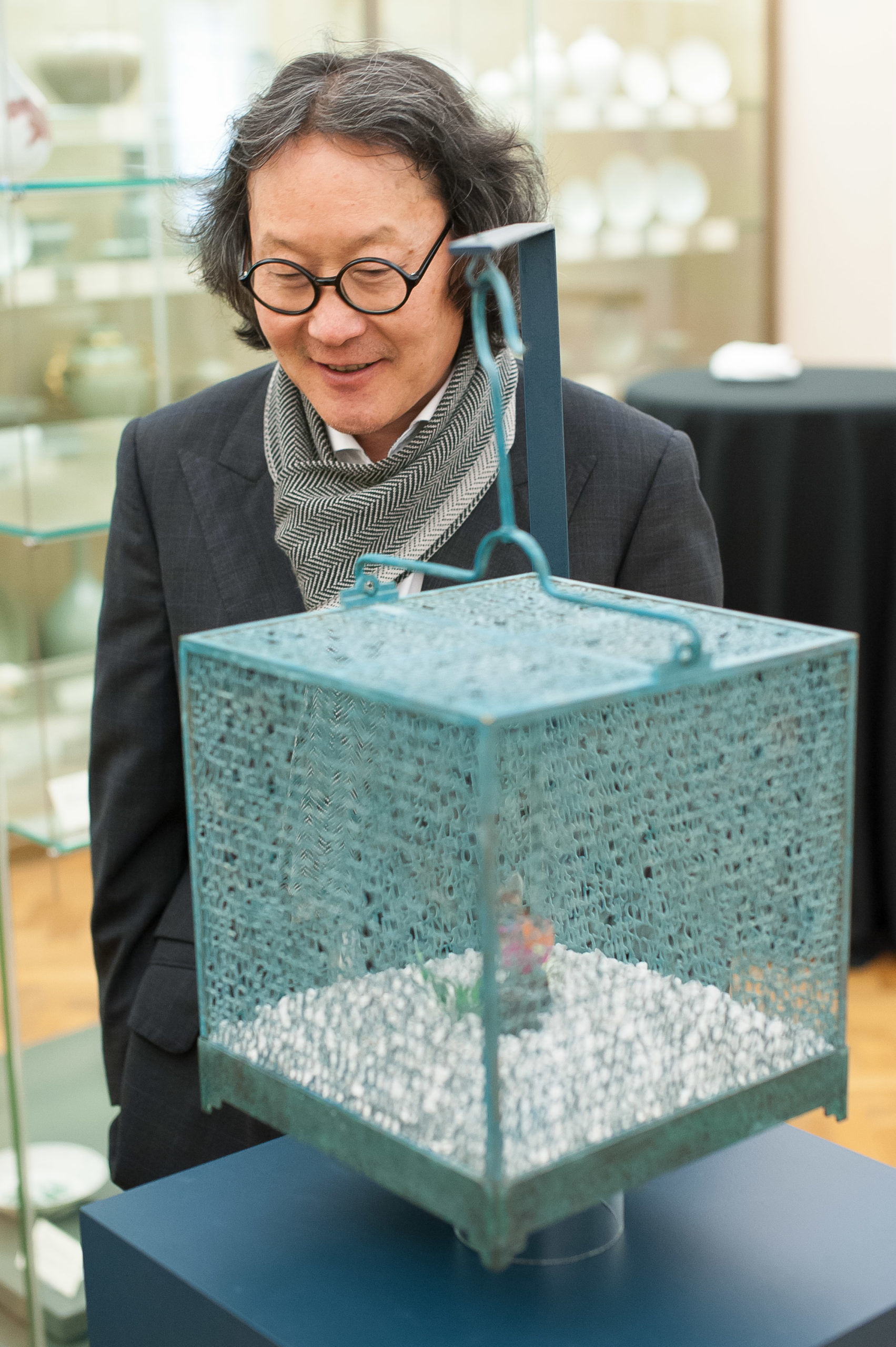Written by Luke Skrebowski (University Lecturer in the History of Art Department)
Fitzwilliam Museum, until Sun 31 May 2015
I recently had the pleasure of attending the opening of Xu Bing’s CRASSH-sponsored installation Bird Language at the Fitzwilliam Museum. This intriguing work, first produced by the artist in 2003, consists of four birdcages each containing a toy songbird. Visitors to the opening quickly discovered that Xu’s birds were sound-activated and could be triggered by a clap or sharp exclamation whereupon the toys whirred into life, spinning on their axes and warbling a cheerful, though repetitive, artificial song.
On closer inspection, visitors also noticed that the metal latticework comprising the toy birds’ cages was formed out of phrases, some of which were written in modern Latin characters and some in what appeared to be Chinese (but were in fact examples of Xu’s “Square Word Calligraphy” – a rendering of English words in the distinctive square form of Chinese ideograms). The cages proved hard to parse, however, and the majority of the crowd quickly tired of attempting to decode them, preferring instead to engage in more playful and immediate modes of interaction with the work.
Conviviality, rather than depth hermeneutics, is of course the order of the day at exhibition openings but what, on further reflection, might we make of Xu Bing’s caged songbirds? In order to respond to this question it is necessary to provide a certain amount of background information. As Fredric Jameson has remarked recently, framing his argument in relation to Xu’s work, contemporary art is elaborated out of “bright ideas” rather than formal innovations and a contextual understanding of these ideas is essential to any meaningful interpretation of them.
It is thus particularly appropriate that the Fitzwilliam has opted to display Bird Language within the East Asian galleries since the keeping of songbirds in China is a longstanding cultural tradition stretching back to the earliest days of the Qing dynasty. Songbird-keeping is considered a virtuous hobby for men that distracts them from vice. This is the case not least because of the amount of time and effort the hobby consumes: songbirds must be intensively cared-for in order to perform at their best, requiring regular feeding, bathing and exercise.
Indeed, it is customary for the songbirds’ owners to take their charges for a daily “walk” where the caged birds are swung through the air (simulating the action of wind on branches and promoting the perched birds to flex their muscles) and which concludes with the birds’ cages being hung en masse from trees in a local park. This provides the birds with a measure of exercise as well as social time, without which it is believed that they lose their impetus to sing. The ritual also serves as a social activity for the birds’ owners, an occasion for conversation and gentle rivalry over different birds’ singing abilities.
 This longstanding tradition of keeping songbirds was, however, interrupted by the Cultural Revolution during which private ownership of pets was forbidden and domestic animals were exterminated in large numbers. While the practice of songbird-keeping was reinstated after the end of the Cultural Revolution, during Deng’s liberalisation of the country, in more recent years the practice has begun to show signs of decline with younger Chinese raising concerns about its ethics.
This longstanding tradition of keeping songbirds was, however, interrupted by the Cultural Revolution during which private ownership of pets was forbidden and domestic animals were exterminated in large numbers. While the practice of songbird-keeping was reinstated after the end of the Cultural Revolution, during Deng’s liberalisation of the country, in more recent years the practice has begun to show signs of decline with younger Chinese raising concerns about its ethics.
The keeping of songbirds thus indexes a broader history of the waxing and waning of traditional cultural practices in China. Xu is best-known as an artist for his reflexive take on such practices which he mediates with Western contemporary art. Trained as a traditional artist, Xu began to experiment with Western approaches during a protracted period of residence in the United States (he moved to New York in 1990 in order to escape official scrutiny of artists’ work after Tiananmen). The songbird also of course symbolises the artist, negotiating the tension between the impulse to “sing” freely while also having to recognise the inevitable, albeit historically varying, social and cultural constraints on artistic practice.
The cages in Bird Language are in fact made from stylised transcriptions of questions that people have asked Xu Bing about his art and the answers that he has provided to these questions. The entire work is a reflection on the status of art and the artist. In Bird Language Xu presents a fusion of Installation art and an ancient Chinese cultural tradition. Here, as elsewhere, he brushes both contemporary art and Chinese tradition against the grain, using each against the other, seeing what kind of productive friction results. The kitsch artificial Chinese songbirds – with all of their symbolic and cultural freight – perform an ironised reflection on their own instrumentalisation in, as and through globalised contemporary art. And it is the work’s audience that is made to make them sing.
Photo credit: Samuel Mather Photography

